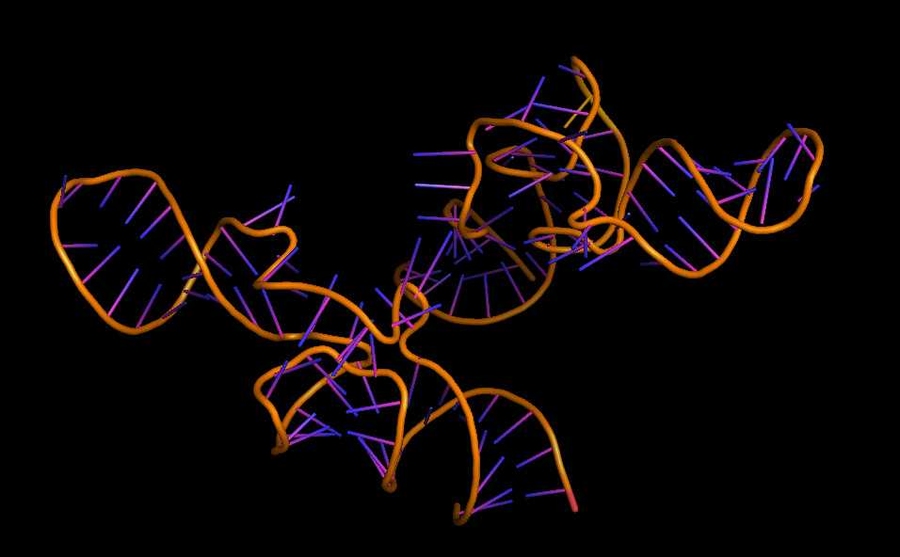When genes were first discovered, the canonical view was that each gene encodes a unique protein. However, biologists later found that segments of genes can be combined in different ways, giving rise to many different proteins.
This phenomenon, known as alternative RNA splicing, often alters the outputs of signaling networks in different tissues and may contribute disproportionately to differences between species, according to a new study from MIT biologists.
After analyzing vast amounts of genetic data, the researchers found that the same genes are expressed in the same tissue types, such as liver or heart, across mammalian species. However, alternative splicing patterns — which determine the segments of those genes included or excluded — vary from species to species.
“The core things that make a heart a heart are mostly determined by a heart-specific gene expression signature. But the core things that make a mouse a mouse may disproportionately derive from splicing patterns that differ from those of rats or other mammals” says Chris Burge, an MIT professor of biology and biological engineering, and senior author of a paper on the findings in the Dec. 20 online edition of Science.
Lead author of the paper is MIT biology graduate student Jason Merkin. Other authors are Caitlin Russell, a former technician in Burge’s lab, and Ping Chen, a visiting grad student at MIT.
A variety of proteins
Alternative RNA splicing (a discovery for which MIT Institute Professor Phillip Sharp shared the 1993 Nobel Prize in medicine or physiology), controls the composition of proteins encoded by a gene. In mammals, genes — made of DNA stored in the cell nucleus — consist of many short segments known as exons and introns. After the DNA is copied into an RNA transcript, all introns and frequently some exons are excised before the messenger RNA (mRNA) leaves the nucleus, carrying instructions to make a specific protein.
This process allows cells to create a much wider variety of proteins than would be possible if each gene encoded only one protein. Some proteins, including Dscam in fruit flies and neurexin in humans, have thousands of alternate forms. These variant proteins can have vastly different functions, Burge says. For example, the full version of a protein may bind to DNA at one end and activate DNA transcription at the other end. If an alternatively spliced form is missing the activation section, it will compete for binding to the same DNA regions as the full-length protein, preventing activation of transcription.
In 2008, Burge and colleagues analyzed mRNA from 10 different human tissues, publishing their results in Nature, and found that nearly every gene is alternatively spliced. Furthermore, most alternative splicing was found to differ among tissues.
In the new study, the researchers compared tissues from several different mammalian species — the rhesus monkey, rat, mouse and cow — as well as one species of bird, the chicken. For each species, the researchers analyzed nine types of tissue (brain, colon, heart, kidney, liver, lung, muscle, spleen and testes) from three individuals, sequencing more than a trillion bases of mRNA.
Using new high-speed sequencing technology, the researchers analyzed both gene expression and alternative splicing patterns in each tissue sample. They found that gene expression patterns were extremely similar across tissues, no matter what species the tissue came from. That is, the genes active in kidney tissue from rats were nearly identical to those turned on in cows’ kidney tissue.
“That was not a big surprise,” Burge says. “It’s consistent with the idea that the gene expression pattern actually determines the identify of the tissue. You need to express certain structural and motor proteins if you’re a muscle cell, and if you’re a neuron you have to express certain synaptic proteins.”
The results from the alternative splicing pattern comparison were very different. Instead of clustering by tissue, the patterns clustered mostly by species. “Different tissues from the cow look more like the other cow tissues, in terms of splicing, than they do like the corresponding tissue in mouse or rat or rhesus,” Burge says.
Because splicing patterns are more specific to each species, it appears that splicing may contribute preferentially to differences between those species, Burge says. “Splicing seems to be more malleable over shorter evolutionary timescales, and may contribute to making species different from one another and helping them adapt in various ways,” he says.
The new study is the first large-scale effort to look at the role of alternative splicing in evolution, says Brenton Graveley, a professor of genetics and developmental biology at the University of Connecticut Health Center. “It provides a lot of new insight into the potential role of alternative splicing in driving differences between species,” says Graveley, who was not involved in this study.
New functions
The researchers also found that a major function of alternative splicing is the addition and deletion of short protein segments that contain one or more phosphorylation sites. Phosphorylation (addition of a phosphate molecule) is a very common way for cells to activate or deactivate proteins.
When a variant form of a protein lacks a key phosphorylation site, it may lose the function of the original form. Phosphorylation can also direct proteins to different locations within the cell, which may alter their function.
Changes in splicing patterns also help to modify the signaling networks that regulate most cellular activity. These networks are often controlled by phosphorylation of proteins involved in the network, many of which can be alternatively spliced. “You can think about it as rewiring signaling networks so they control different outputs. Splicing can add a new output or delete it in a tissue-specific way,” Burge says.
The researchers also identified several thousand new alternative exons in each species, and are now studying how these exons evolved and exploring their potential functions.
The research was funded by a Broad Institute SPARC grant, the National Institutes of Health and the National Science Foundation.
This phenomenon, known as alternative RNA splicing, often alters the outputs of signaling networks in different tissues and may contribute disproportionately to differences between species, according to a new study from MIT biologists.
After analyzing vast amounts of genetic data, the researchers found that the same genes are expressed in the same tissue types, such as liver or heart, across mammalian species. However, alternative splicing patterns — which determine the segments of those genes included or excluded — vary from species to species.
“The core things that make a heart a heart are mostly determined by a heart-specific gene expression signature. But the core things that make a mouse a mouse may disproportionately derive from splicing patterns that differ from those of rats or other mammals” says Chris Burge, an MIT professor of biology and biological engineering, and senior author of a paper on the findings in the Dec. 20 online edition of Science.
Lead author of the paper is MIT biology graduate student Jason Merkin. Other authors are Caitlin Russell, a former technician in Burge’s lab, and Ping Chen, a visiting grad student at MIT.
A variety of proteins
Alternative RNA splicing (a discovery for which MIT Institute Professor Phillip Sharp shared the 1993 Nobel Prize in medicine or physiology), controls the composition of proteins encoded by a gene. In mammals, genes — made of DNA stored in the cell nucleus — consist of many short segments known as exons and introns. After the DNA is copied into an RNA transcript, all introns and frequently some exons are excised before the messenger RNA (mRNA) leaves the nucleus, carrying instructions to make a specific protein.
This process allows cells to create a much wider variety of proteins than would be possible if each gene encoded only one protein. Some proteins, including Dscam in fruit flies and neurexin in humans, have thousands of alternate forms. These variant proteins can have vastly different functions, Burge says. For example, the full version of a protein may bind to DNA at one end and activate DNA transcription at the other end. If an alternatively spliced form is missing the activation section, it will compete for binding to the same DNA regions as the full-length protein, preventing activation of transcription.
In 2008, Burge and colleagues analyzed mRNA from 10 different human tissues, publishing their results in Nature, and found that nearly every gene is alternatively spliced. Furthermore, most alternative splicing was found to differ among tissues.
In the new study, the researchers compared tissues from several different mammalian species — the rhesus monkey, rat, mouse and cow — as well as one species of bird, the chicken. For each species, the researchers analyzed nine types of tissue (brain, colon, heart, kidney, liver, lung, muscle, spleen and testes) from three individuals, sequencing more than a trillion bases of mRNA.
Using new high-speed sequencing technology, the researchers analyzed both gene expression and alternative splicing patterns in each tissue sample. They found that gene expression patterns were extremely similar across tissues, no matter what species the tissue came from. That is, the genes active in kidney tissue from rats were nearly identical to those turned on in cows’ kidney tissue.
“That was not a big surprise,” Burge says. “It’s consistent with the idea that the gene expression pattern actually determines the identify of the tissue. You need to express certain structural and motor proteins if you’re a muscle cell, and if you’re a neuron you have to express certain synaptic proteins.”
The results from the alternative splicing pattern comparison were very different. Instead of clustering by tissue, the patterns clustered mostly by species. “Different tissues from the cow look more like the other cow tissues, in terms of splicing, than they do like the corresponding tissue in mouse or rat or rhesus,” Burge says.
Because splicing patterns are more specific to each species, it appears that splicing may contribute preferentially to differences between those species, Burge says. “Splicing seems to be more malleable over shorter evolutionary timescales, and may contribute to making species different from one another and helping them adapt in various ways,” he says.
The new study is the first large-scale effort to look at the role of alternative splicing in evolution, says Brenton Graveley, a professor of genetics and developmental biology at the University of Connecticut Health Center. “It provides a lot of new insight into the potential role of alternative splicing in driving differences between species,” says Graveley, who was not involved in this study.
New functions
The researchers also found that a major function of alternative splicing is the addition and deletion of short protein segments that contain one or more phosphorylation sites. Phosphorylation (addition of a phosphate molecule) is a very common way for cells to activate or deactivate proteins.
When a variant form of a protein lacks a key phosphorylation site, it may lose the function of the original form. Phosphorylation can also direct proteins to different locations within the cell, which may alter their function.
Changes in splicing patterns also help to modify the signaling networks that regulate most cellular activity. These networks are often controlled by phosphorylation of proteins involved in the network, many of which can be alternatively spliced. “You can think about it as rewiring signaling networks so they control different outputs. Splicing can add a new output or delete it in a tissue-specific way,” Burge says.
The researchers also identified several thousand new alternative exons in each species, and are now studying how these exons evolved and exploring their potential functions.
The research was funded by a Broad Institute SPARC grant, the National Institutes of Health and the National Science Foundation.






